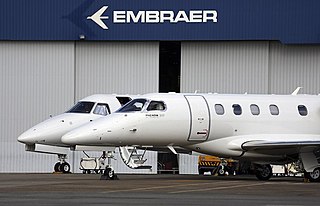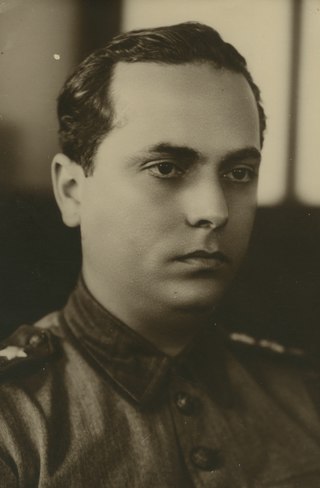Related Research Articles

Gol Linhas Aéreas Inteligentes S.A is a Brazilian low-cost airline based in Rio de Janeiro, Brazil. According to the National Civil Aviation Agency of Brazil (ANAC), between January and December 2019 Gol had 37.7% of the domestic and 3.8% of the international market shares in terms of passengers per kilometer flown, making it the largest domestic and third largest international airline in Brazil.

Embraer S.A. is a Brazilian multinational aerospace corporation. It designs, manufactures, and sells commercial, military, executive, and agricultural aircraft, as well as provides leasing and aviation support services. Embraer is the third largest producer of civil aircraft after Boeing and Airbus, and the leading provider of regional jets worldwide; it is also among the world's top 100 defense contractors. The company is headquartered in São José dos Campos, São Paulo.

The AMX International AMX is a ground-attack aircraft jointly developed by Brazil and Italy. The AMX is designated A-11 Ghibli by the Italian Air Force and A-1 by the Brazilian Air Force. The Italian name, "Ghibli", is taken from the hot dry wind of the Libyan desert.

The Brazilian Air Force is the air branch of the Brazilian Armed Forces and one of the three national uniformed services. The FAB was formed when the Army and Navy air branches were merged into a single military force initially called "National Air Forces" in 1941. Both air branches transferred their equipments, installations and personnel to the new force.

The Embraer EMB 120 Brasilia is a twin-turboprop 30-passenger commuter airliner designed and manufactured by the Brazilian aircraft manufacturer Embraer.

OGMA – Indústria Aeronáutica de Portugal S.A. is a Portuguese aerospace company focused on aircraft maintenance and manufacturing.

The Embraer EMB 314 Super Tucano, also named ALX or A-29, is a Brazilian turboprop light attack aircraft designed and built by Embraer as a development of the Embraer EMB 312 Tucano. The A-29 Super Tucano carries a wide variety of weapons, including precision-guided munitions, and was designed to be a low-cost system operated in low-threat environments.

The Embraer EMB 202 Ipanema is a Brazilian agricultural aircraft used for aerial application, particularly crop dusting. It is produced by Indústria Aeronáutica Neiva, a subsidiary of Embraer located in Botucatu, Brazil. The latest version of this aircraft is the first ethanol-powered fixed-wing aircraft, which could give it an economical advantage over the gasoline version. The aircraft is widely employed in Brazil, having market share of about 80%, and the 1,000th delivery was completed on 15 March 2005. Besides aircraft, alcohol-conversion kits for gasoline-powered Ipanemas are also sold.

Indústria Aeronáutica Neiva is a subsidiary of Embraer which produces airplanes and aircraft components. Its main product is the Embraer EMB 202 Ipanema, the most employed agricultural aircraft in Brazil and the first alcohol-powered airplane. Neiva delivered more than 3,700 aircraft until early 2006.

Gol Transportes Aéreos Flight 1907 was a scheduled domestic passenger flight from Manaus, Brazil, to Brasília and Rio de Janeiro. On 29 September 2006, the Boeing 737-800 operating the flight collided with an Embraer Legacy 600 business jet over the Brazilian state of Mato Grosso. The winglet-equipped wingtip of the Legacy sliced off about half of the 737's left wing, causing the 737 to break up in midair and crash into an area of dense jungle, killing all 154 passengers and crew. Despite sustaining serious damage to its left wing and tail, the Legacy landed with its seven occupants uninjured.

The Embraer C-390 Millennium is a medium-size, twin-engine, jet-powered military transport aircraft designed and produced by the Brazilian aerospace manufacturer Embraer. It is the heaviest aircraft the company has constructed to date.

SuperVia Trens Urbanos is a rapid transit and commuter rail company operator, founded in Rio de Janeiro (Brazil) in November 1998. It carries around 750,000 passengers a day on a railroad network comprising 104 stations in 12 cities: Rio de Janeiro, Duque de Caxias, Guapimirim, Nova Iguaçu, Nilópolis, Mesquita, Queimados, São João de Meriti, Belford Roxo, Japeri, Paracambi and Magé.

The Aeromot AMT-200 Super Ximango is a Brazilian motor glider developed from the AMT-100 Ximango but fitted with a Rotax 912 engine.

The Aeromot AMT-100 Ximango is a Brazilian motor glider developed from the Fournier RF-10.

Piquiatuba Transportes Aéreos is a domestic airline based in Santarém, Pará, Brazil. Founded in 2005 it operates regular charter flights.

Antônio Guedes Muniz was the pioneer of the Brazilian aviation industry.
The Aeromot AMT-300 Turbo Ximango Shark is a Brazilian motor glider manufactured by the aerospace company Aeromot.

Eve Air Mobility is a Brazilian subsidiary of Embraer which produces electric vertical take-off and landing (eVTOL) aircraft and urban air mobility infrastructure. The company was founded on 15 October 2020. EVE is a brand that was idealized by the innovation division of Embraer called EmbraerX.
References
- ↑ "AEROMOT NA COPA DO MUNDO DE 2014 E OLIMPÍADAS RIO 2016 (in Portuguese)". Archived from the original on November 24, 2017. Retrieved June 23, 2021.
- 1 2 "Aeromot inaugura nova era na aviação (in Portuguese)". Archived from the original on February 15, 2009. Retrieved March 23, 2004.
- 1 2 3 4 "HISTÓRICO DAS ATIVIDADES DA AEROMOT (in Portuguese)" (PDF). Archived from the original (PDF) on July 16, 2015. Retrieved June 23, 2021.
- 1 2 "Aeromot tenta produzir motoplanador Ximango na China (in Portuguese)". Archived from the original on April 3, 2019. Retrieved January 28, 2003.
- ↑ "HISTÓRICO DAS ATIVIDADES DA AEROMOT (in Portuguese)". Archived from the original on March 22, 2016. Retrieved June 23, 2021.
- ↑ "The Company (in Portuguese)". Archived from the original on October 24, 2008. Retrieved June 23, 2021.
- ↑ Pereira, Roberto (1997). Enciclopédia de Aviões Brasileiros. São Paulo: Editora Globo. pp. 19–20. ISBN 9788525021373.